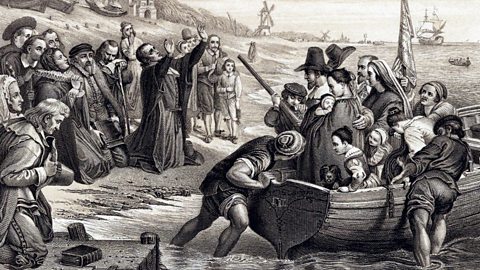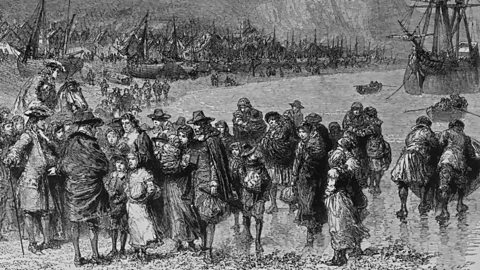Ulster Plantations, Pilgrim Fathers and the migration of Huguenots
Looking West
The 16th and 17th centuries were periods of tremendous change in Britain and Europe. Christianity was still the dominant intellectual force but it had been strongly influenced by the cultural RenaissanceThe revival or rebirth of European art and literature under the influence of classical Roman and Greek culture during the 14th to 16th centuries. of the 15th century. The intellectual developments of the Scientific Revolution in the 17th century also played a part in instigating change throughout Europe.
The ChristianA person who had been baptised or who is a believer in Jesus and his teachings. Church became divided into CatholicChristians whose religious leader is the Pope. and ProtestantChristians who broke away from the Roman Catholic Church during the Reformation. They believe in the teachings of the Bible but reject the authority of the Pope. through a movement called the ReformationThe 16th century religious revolution that led to the establishment of the Protestant churches.. These changes produced a number of situations where groups of people decided to migrate because of their religion.
Ulster Plantations and migration to Ireland
In the 16th century, England became a Protestant country, but this change did not happen in Ireland.
- The English government had faced a lot of challenges in Ireland through the Middle Ages, and had tried to control the island from its base in Dublin. Towards the end of Queen Elizabeth IÔÇÖs reign, the English fought a Nine YearsÔÇÖ War in Ireland to establish English control and to remove the power of the Irish Catholic nobleSomeone of high rank with a title..
After this war, in 1607 during the reign of King James I of Britain, a plan was devised to settle Protestants in Ulster, taking the lands of a group of Ulster Catholic nobles who had fled the country.
The majority of the new Protestant settlers came from Scotland, and the idea was that they would not allow Catholics to stay on their land or work for them, so that the whole area became Protestant. Protestant church ministers migrated to Ulster to convert the native Irish to the Protestant faith. King James was clear about the religious purpose of the migration.
To King James the Plantation of Ulster would be a civilising enterprise that would:
Establish the true religion of Christ among men almost lost in superstition.
In the end the new Protestant Ulster people did not drive the native Catholics away, and they ended up living alongside each other, although the Catholics were not as privileged as they had previously been.
Pilgrim Fathers and migration to America
Some Protestants in England, known as PuritanStrict Protestants who wanted to get rid of ritual in church services and lead a plain and simple life., thought that the new Church needed to be stricter and plainer to keep it as far away as possible from the old Catholic traditions. A particular group of Puritans decided that England would never give them the chance to follow their religion in the way they wanted, so they migrated from England. They were separatistsGroups that pushed for separation from the British Empire. and would later be called pilgrimA person who performs a journey which has religious or spiritual significance, known as a pilgrimage..
Pilgrim journeys
Migration one: 1606-07 ÔÇô from England to the Netherlands
Pilgrims migrated to the city of Leiden in the Netherlands, where they would not have to obey the Church of EnglandThe Church of England (C of E) is the official Protestant state religion of England. Its supreme governor is the monarch of the UK, with the Archbishop of Canterbury as the most senior priest.. As the years passed, the separatists became concerned that they would lose their identity as English if they remained in Dutch society, and so they decided to migrate to the Americas and set up their own colony.
Migration two: 1620 ÔÇô from the Netherlands to the Americas on the Mayflower

Pilgrims migrated to the colony of New Plymouth, deliberately trying to settle far away from the colony in Virginia. This was because the Virginia colony was connected to the English establishment and the Pilgrims were concerned that they might try to control their religious practice. They sailed much further north and came to the area around Cape Cod and what was to become Massachusetts and New England.
Liberty and the Pilgrims
The Pilgrims were not in favour of the new colonists having complete liberty and freedom, because they were worried that some of the people on the voyage who were not Pilgrims would set up their own religious practice. So, before they got off the boat, the Pilgrims signed a ÔÇśMayflower CompactÔÇÖ to set up laws for the colony unto which we promise all due submission and obedience
. The compact did not mention liberty or rights.
Pilgrims and natives
When they landed and set up their colony they immediately had contact with the native Americans. Initially the Pilgrims and the natives were friendly and supported each other, including helping the settlers to grow corn. However, some of the native tribes fought against the new settlers when they expanded into more of the native lands.
Huguenots migrating to Britain

In France the ReformationThe 16th century religious revolution that led to the establishment of the Protestant churches. had caused a lot of divisions through the 16th and 17th centuries. Although the French monarchyA country ruled by a king or queen. and state was Catholic, there were many Protestants in France, called HuguenotsFrench Protestants, many of whom came to England as refugees in the 16th and 17th centuries..
During the late 16th century there was a long period of religious civil warA war between groups of people from the same country., which ended in 1598 when France agreed to tolerate the Huguenots under a new law called the Edict of Nantes. However, in 1685 the French king Louis XIV decided to make Protestantism illegal in France.
As a result of this religious persecution and suffering, thousands of Huguenots left France and migrated to Britain and other Protestant countries.
The Huguenots arrive in Sussex
More guides on this topic
- Britain, migration and empire overview, c790 - present day
- Motives for migration to and from Britain - economics and commerce
- Motives for migration to and from Britain - war and government
- Motives for migration to and from Britain - geographical summary
- Migration's effect on Britain - economics and commerce
- Migration's effect on Britain - religion and ideas
- Migration's effect on Britain - government
- How Britain gained an empire - economics and commerce
- How Britain gained an empire - religion and ideas
- How Britain gained an empire - war
- How Britain gained an empire - government
- How Britain gained an empire - geographical summary
- How Britain lost an empire - ideas, race and culture
- How Britain lost an empire - war and government
- How Britain lost an empire - geographical summary
- Britain: Migration, empires and the people - exam preparation